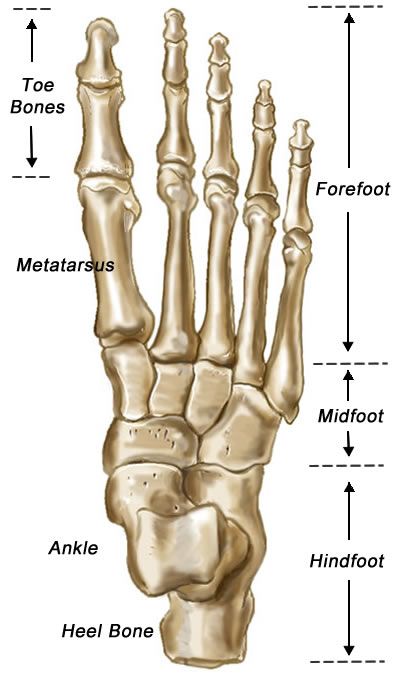
Anatomy
There are 26 bones in each of your feet. These foot bones are joined by 33 joints and hundreds of muscles, tendons, and ligaments to form a complex mechanism that have allowed human beings to move, walk, jump, and run for thousands of years. The foot can be subdivided into three areas: the hindfoot, the midfoot, and the forefoot. The following foot bones can be found in each of these groups:t is the area that is located at the back of your foot, and its bones are cushioned by a layer of fatty tissue. It includes the following foot bones:
Hindfoot
- The hindfoot is the area that is located at the back of your foot, and its bones are cushioned by a layer of fatty tissue. It includes the following foot bones:
- Tibia and fibula: these two bones form your legs, but their distal ends connect to the bones in your feet, forming the medial and lateral malleoli.
- Talus: this is the highest foot bone, and it forms the bottom of your ankle joint.
- Calcaneus: also known as the heel bone, this is the largest of all the foot bones.
 Midfoot
Midfoot
- The midfoot forms the arch of your feet, which aids in shock absorption. It is held together by the plantar fascia, along with muscles and tendons. It is formed by:
- Cuboid: this foot bone is located on the lateral edge of your foot. It forms joints to numerous other bones to give the foot strength and stability.
- Navicular: this bone can be found on the medial portion of the foot, and is also part of numerous joints.
- Cuneiforms: there are three cuneiform bones (medial, intermediate, and lateral).
Rearfoot
- The forefoot is where your toes are located. This are includes the following foot bones:
- Metatarsals: there are five metatarsals that form joints between your toes and the foot bones in your midfoot.
- Phalanges: each toe is formed by three phalanges (proximal, medial, and distal phalanges). The only toe that doesn’t follow this rule is the hallux or big toe, which is only formed by two phalanges. The big toe only has proximal and distal phalanges, and it lacks a medial phalange.
All these foot bones form joints and provide support to foot muscles and their tendons. It is thanks to these structures that we are able to perform our daily tasks, sports, and hobbies.
If you are having foot pain please consult with a Podiatrist Sydney


 Midfoot
Midfoot







